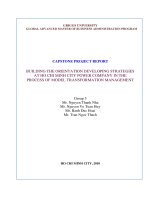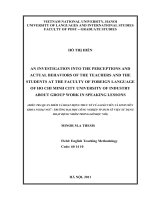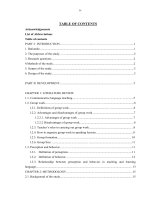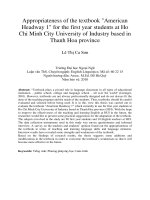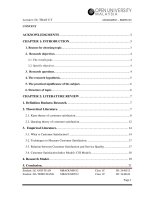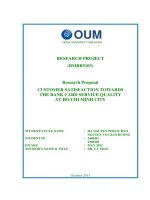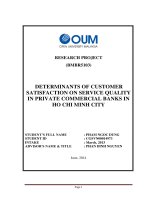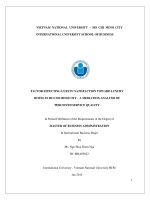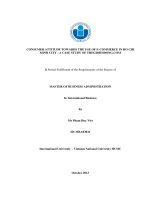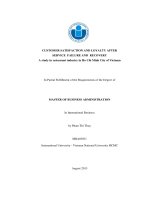Customer satisfaction towards the bank card service quality at ho chi minh city
Bạn đang xem bản rút gọn của tài liệu. Xem và tải ngay bản đầy đủ của tài liệu tại đây (222.52 KB, 43 trang )
OUM
RESEARCH PROJECT
(BMBR5103)
Research Proposal
CUSTOMER SATISFACTION TOWARDS
THE BANK CARD SERVICE QUALITY
AT HO CHI MINH CITY
STUDENT’S FULL NAME : HA NGUYEN PHUOC BAO
NGUYEN VO GIAO HUONG
STUDENT ID : 2448461
2448448
INTAKE : MAY 2012
ADVISOR’S NAME & TITLE : DR. UT TRAN
October 2013
OPEN UNIVERSITY MALAYSIA
Business Research Methods
Ha Nguyen Phuoc Bao
&
Nguyen Vo Giao Huong
ADVISOR’S ASSESSMENT
Advisor’s signature
Business Research Methods
Ha Nguyen Phuoc Bao
&
Nguyen Vo Giao Huong
ACKNOWLEDGEMENT
We would like to express our special thanks of gratitude to our teacher – Dr. Ut
Tran who gave us the golden opportunity to study a lot of information knowledge
about Business Research Methods. Through Assignment on the title: Customer
satisfaction towards the bank card service quality at Ho Chi Minh city, which also
helped us in doing a lot of research and we came to know about so many new things.
We are really thankful to Dr. Ut Tran.
With kindest regards,
Ha Nguyen Phuoc Bao
& Nguyen Vo Giao Huong
Business Research Methods
Ha Nguyen Phuoc Bao
&
Nguyen Vo Giao Huong
Table of contents
Executive summary 1
CHAPTER 1: INTRODUCTION
1.1. Research background 2
1.2. Research statement 3
1.3. Research objectives and the scope of the research 4
1.4. Research significance 5
CHAPTER 2: LITERATURE REVIEW
2.1. Research definition 6
2.1.1. Service quality 6
2.1.2. Customer satisfaction 10
2.1.3. Relationship between service quality and customer satisfaction 11
2.2. Related research 13
2.3. Related model in an analysis 15
2.4. Theoretical framework 22
CHAPTER 3: RESEARCH METHODOLOGY
3.1. Type of the research 26
3.2. Research design 27
3.2.1. Data collection 28
3.2.2. Data analysis 31
3.2.3. Budget 33
3.3. Activity plan 33
References 35
Business Research Methods
Ha Nguyen Phuoc Bao
&
Nguyen Vo Giao Huong
Figures
Figure 1: Gaps model of service quality 17
Figure 2: Conceptual framework 22
Tables
Table 1: Relation between original model and adjusted model 20
Table 2: Estimated for cost of survey 33
Charts
Chart 1: Activity plan 34
Business Research Methods
Ha Nguyen Phuoc Bao
&
Nguyen Vo Giao Huong Page | 1
EXECUTIVE SUMMARY
The study focused on finding the relationship between service quality variables
and customer satisfaction toward bank card in Ho Chi Minh city. Service quality and
customer satisfaction are very important concepts that companies must understand in
order to remain competitive in business and grow. Customer responses were measured
through an adapted questionnaire on a 5-point Likert scale. Hard copy questionnaire
were distributed customer using card at the other banks and malls in Ho Chi Minh city.
Total number of sample collected was 477. The data was analyzed using SPSS.
Frequency, ANOVA, T-Test and Correlation analysis are used for to assess the
hypothesis. The correlation analysis provided full support to prove almost all the
hypothesis relation. Reliability test used for the data are actually reliable or not. And
Frequency used for what percentages of people are answering the question for support
the hypotheses. The results showed there is significant relationship between the service
quality variables. The results also showed that there was a difference in satisfaction
level between customer who are using card at the bank in Ho Chi Minh city.
From this study the banks will get useful feedback on their actual service quality
and know their customers’ satisfaction level from using bank card to improve better
card service quality in future. Although we only make study customer satisfaction
towards service quality the bank card at Ho Chi Minh city but we make sure it also
shows overview picture of the market card in Vietnam.
Business Research Methods
Ha Nguyen Phuoc Bao
&
Nguyen Vo Giao Huong Page | 2
CHAPTER 1: INTRODUCTION
This chapter presents the introduction to the study. It entails the research
background, research problem statement, research objective and scope of the research,
and research significance.
1.1. Research background
Customer satisfaction is imperative for the long term success of any
organization. Generally, any organization needs to know how to keep their customers,
even if they seem to be satisfied. This can basically determine the success and
profitability of a company as a satisfied customer would most likely to spread the good
word or would have be happy to do business again with the firm.
The banking industry is highly competitive, most bank product developments
are easy to duplicate and when banks provide nearly identical services, they can only
distinguish themselves on the basis of brand of bank, price and quality. Therefore,
customer satisfaction is potentially an effective tool that banks can use to gain a
strategic advantage and survive in today’s ever-increasing banking competitive
environment.
Banks are the financial institutions that provide different services through
deposit products, loan-products and card products is one of the prominent service of
bank, which offers customers 24 hours banking access, such as cash withdrawal,
purchasing of goods and services, and so on.
In today’s fast-paced and increasingly competitive market, keeping the
importance of customer satisfaction in mind, banks need to maintain stable and close
relationships with their customers. Customer satisfaction levels need to be judged.
Therefore, my group decided to study “Customer satisfaction towards the bank card
service quality at Ho Chi Minh city” to assess customer satisfaction and look for the
opportunity to improve card service quality.
Business Research Methods
Ha Nguyen Phuoc Bao
&
Nguyen Vo Giao Huong Page | 3
1.2. Research statement
Customer satisfaction gives an indication of how successful the organization is
for its products or services in the market. Because it is said that customer is the God.
With title of study "Customer satisfaction towards the bank card service quality at
HCM city", we will consider to measure the satisfaction level of bank card users of
different private commercial banks and to improve customer satisfaction toward card
service quality. In the current trend, customer satisfaction identify the factors of service
quality and according to this service quality can be evaluated based on five dimensions
including reliability, assurance, tangible, empathy and responsiveness.
‒ Reliability: Ability to perform the service dependably and accurately.
‒ Assurance: Employees’ knowledge and courtesy and their ability to inspire trust
and confidence.
‒ Tangibles: Appearance of physical facilities, equipment, personnel and
communication materials.
‒ Empathy: Caring, individualized attention given to customers.
‒ Responsiveness: Willingness to help customers, provide prompt service and
solve problems.
All activities of the banks are directed towards customer satisfaction which
leads to customer retention, a key factor for achieving the goal of banking business.
Such as:
Service quality was determined as the subjective comparison that customers
make between their expectations about a service and awareness of how the service is
run. Parasuraman (1985) defined service quality as a function of the differences
between expectation and performance along ten major dimensions. In later research,
Parasuraman (1988) revised and defined the service quality in terms of five
dimensions: tangibility, reliability, responsiveness, assurance, and empathy.
Business Research Methods
Ha Nguyen Phuoc Bao
&
Nguyen Vo Giao Huong Page | 4
In the banking industry, most researchers are interested in customer satisfaction
maximization. Hernon & Whitwan (2001) defined customer satisfaction as a measure
of how the customer perceives service delivery. For this reason, it is important to
understand how customer expectation is formed in order to identify the factors of
service satisfaction.
The fact that different customers have different expectations, based on their
knowledge about a product or service. This may imply that a customer can make
estimates of the service will be or might be thinking that what should be done. If you
perform services that meet or exceed customer expectations, customers will be
satisfied. On the other hand, customers are more likely to be satisfied if the provision
of services is less than what they have expected.
From this study the banks will get useful feedback on their actual service quality
and know their customers’ satisfaction level from using bank card, which in turn will
help them take positive steps to improve card service quality and to maintain a
competitive edge. Beside, some recommendations are made on the basis of the
measurement of satisfaction for better card services in future.
1.3. Research objectives and the scope of the research
Research objectives:
In the light of the above, the main objective of this study is to identify the
banking services in HCM city. The study is conducted with the following objectives
below:
Identify the factors of customers’ satisfaction according to the model Servqual
(Parasuraman, 1988).
To measure customer satisfaction of bank card services in HCM city.
Make comparative analysis of customer satisfaction at banks survey.
Draw conclusions and make recommendations on what banks should do to
increase customer satisfaction toward its card services.
Business Research Methods
Ha Nguyen Phuoc Bao
&
Nguyen Vo Giao Huong Page | 5
Scope of the research:
A number of surveys are conducted in HCM city. This study is mainly confined
to the customer preference and satisfaction towards banking services only, who have
been using the particularly card.
The survey is conducted from July to October, 2013 in HCM city.
Limitation of the research:
Every research has some limitations. In conducting this research the following
limitations are faced:
Sometimes respondents were reluctant to provide information.
The primary data is collected through a structured questionnaire and the sample
size is only limited to respondents.
1.4. Research significance
With the phenomenal increase in the country's population and the increased
demand for banking services, speed, service quality and customer satisfaction are going
to be key differentiators for each bank's future success.
There is an overview of the level of customer satisfaction with service quality of
the bank card and identify the factors of customers‘ satisfaction based on to evaluate
objectively customer needs and quality of service issuer current card.
From the study, we make recommendation to enhance the performance of the
bank and help customers satisfied when using the bank card service.
And the lastly, the study contributes to completing framework of customer
satisfaction measurement on bank card service quality.
Business Research Methods
Ha Nguyen Phuoc Bao
&
Nguyen Vo Giao Huong Page | 6
CHAPTER 2: LITERATURE REVIEW
This chapter covers the literature reviewed of Theories, models and empirical
evidence of the variables of the study - service quality and customer satisfaction. The
literature reviewed include: research definition, Related research, Related Model in
analysis, and theoretical framework.
2.1. Research definition
2.1.1. Service quality
a. Service concept:
Up to now, there is no definition of acceptable service on a global scale. The
diversity, complexity and invisible of the type of service make the service definition
more than difficult.
According to Zeithaml & Britner (2000), the service is the behaviors, process,
method to perform certain task in order to create value for customers to use, and to
satisfy customer expectations.
According to Kotler & Armstrong (2004), service is an act or performance
offered by one party to another. They are the economic activities create value and
benefits for customers at times and specific locations as a result of bringing the desired
change that the business can provide to clients establish, strengthen and expand
relationships and long-term cooperation with customers.
According to the marketing experts and management thinkers the concept of
services is a wider one. The term services are defined in a number of ways but not a
single one is universally accepted. The distinct characteristics of services are
mentioned below:
‒ Intangibility: Services are intangible and insubstantial: they cannot be touched,
gripped, handled, looked at, smelled, and tasted. To overcome this, consumers
tend to look for evidence of quality and other attributes, for example in the
Business Research Methods
Ha Nguyen Phuoc Bao
&
Nguyen Vo Giao Huong Page | 7
decor and surroundings of the beauty salon, or from the qualifications and
professional standing of the consultant (Robinson, 1999).
‒ Heterogeneity Invariability: Because a service is produced and consumed
simultaneously, and because individual people make up part of the service
offering, it can be argued that a service is always unique; it only exists once, and
is never exactly repeated. This can give rise to concern about service quality and
uniformity issues. The quality of services cannot be standardized. This is due to
the difference in perception of individuals at the level of providers and users.
Heterogeneity makes it difficult to establish standards for the output of service
firm (Caruana & Pitt, 1997).
‒ Inseparability: Services are generally created or supplied simultaneously. They
are inseparable. Such the entertainment industry, health experts and other
professionals create and offer their service at the same given time. Services and
their providers are associated closely and thus, not separable. Therefore
inseparability is an important characteristic of services which proves
challenging to service management industry (Svensson, 2002).
‒ Perishability: Services are perishable; they cannot be stored. Perishability does
not pose too much of a problem when demand for a service is steady, but in
times of unusually high or low demand service organisations can have severe
difficulties.
b. Quality concept:
Quality has many different definitions and there is no universally acceptable
definition of quality. They claim it is because of the elusive nature of the concept from
different perspectives and orientations and the measures applied in a particular context
by the person defining it. This means that the definition of quality differences between
manufacturing and service industries and among scholars and practitioners
Business Research Methods
Ha Nguyen Phuoc Bao
&
Nguyen Vo Giao Huong Page | 8
These variations are caused by the intangible nature of its components since it
makes it very difficult to evaluate quality which cannot be assessed physical implying
other ways must be outlined in order to measure this quality.
Some definitions of quality pointed out by Hardie & Walsh (1994, p.53)
include:
‒ According to Juran, 1985: Quality is product performance which results in
customer satisfaction freedom from product deficiencies, which avoids customer
dissatisfaction.
‒ According to Gitlow et al., 1989: Quality is the extent to which the customers or
users believe the product or service surpasses their needs and expectations.
‒ According to International Standards Organization (ISO): Quality: the totality of
features and characteristics of a product that bear on its ability to satisfy stated
or implied needs.
‒ According to Wicks & Roethlein, 2009: Quality is defined as the summation of
the affective evaluations by each customer of each attitude object that creates
customer satisfaction.
The above definitions of quality shed light in understand quality concept.
Quality is a perceptual, conditional and somewhat subjective attribute and may be
understood differently by different people. Consumers may focus on the specification
of a product/service, or how it compares to competitors in the marketplace.
Organizations might measure the conformance, or degree to which the product/service
was produced correctly.
c. Service quality:
There are many researchers who have defined service quality in different ways
as service quality is the result of the comparison that customers make between their
expectations about a service and their perception of the way the service has been
Business Research Methods
Ha Nguyen Phuoc Bao
&
Nguyen Vo Giao Huong Page | 9
performed (Gronroos, 1984; Parasuraman et al., 1985; 1988; Caruana, 2002). However,
there are also many others define such as:
According to Asubonteng et al. (1996) define service quality as the different
between customers’ expectations for service performance prior to the service encounter
and their perceptions of the service received.
According to Gefan (2002) define service quality as the subjective comparison
that customers make between the quality of the service that they want to receive and
what they actually get.
According to Parasuraman &ctg (1985, 1988) define service quality is
determined by the differences between customer’s expectations of services provider’s
performance and their evaluation of the services they receive.
Service quality is a focused evaluation that reflects the customer‘s perception of
elements of service such as interaction quality, physical environment quality, and
outcome quality. These elements are in turn evaluated based on specific quality
dimensions: reliability, responsiveness, assurance, empathy and tangibles. Satisfaction,
on the other hand, is more inclusive: it is influenced by perceptions of service quality,
product quality, and price as well as situational factors and personal factors. According
to Parasuraman, Zeithaml and Berry (1988), five principal dimensions that customers
use to judge service quality include reliability, responsiveness, assurance, empathy, and
tangibles as shown below.
‒ Reliability: the ability to perform the promised services both dependably and
accurately. Reliable service performed is a customer’s expectation and means
that the service is accomplished on time, in the same manner, and without error
every time.
‒ Responsiveness: the willingness to help customers and to provide prompt
service. Keeping customers waiting particularly for no apparent reason creates
unnecessary negative perceptions of quality. If a service failure occurs, the
Business Research Methods
Ha Nguyen Phuoc Bao
&
Nguyen Vo Giao Huong Page | 10
ability to recover quickly and with professionalism can create very positive
perceptions of quality.
‒ Assurance: the knowledge and courtesy of employees as well as their ability to
convey trust and confidence. The assurance dimension includes the following
features: competence to perform the service, politeness and respect for the
customer, effective communication with the customer, and the general attitude
that the server has the customer‘s best interests at heart.
‒ Empathy: the provision of caring, individualized attention to customers.
Empathy includes the following features: approachability, sensitivity and effort
to understand the customer‘s needs.
‒ Tangibles: the appearance of physical facilities, equipment, personnel, and
communication materials. The condition of the physical surroundings is tangible
evidence of the care and attention to detail that are exhibited by the service
provider. This assessment dimension also can extend to the conduct of other
customers in the service.
Without any doubt, service quality is very important component in any business
related activity. This is especially so, to marketer a customer’s evaluation of service
quality and the resulting level of satisfaction are perceived to affect bottom line
measures of business success.
2.1.2. Customer satisfaction
Kotler (1996) defined customer satisfaction as the level of a person felt state
resulting from comparing a product’s perceived performance or outcome in violation to
them own expectations. Therefore, customer satisfaction can be regarded as an act of
comparison between input before hand and all obtainments. As the research focuses on
the satisfaction survey of library use, customer satisfaction is defined as the level of
quality of service performance meets user expectations.
Business Research Methods
Ha Nguyen Phuoc Bao
&
Nguyen Vo Giao Huong Page | 11
Substantial research has been done in the field of customer satisfaction. Various
researchers have defined customer satisfaction in different ways:
‒ Customer satisfaction is a person’s feelings of pleasure or disappointment that
result from comparing a product’s perceived performance to their expectations.
(Oliver, 1980)
‒ Satisfaction is the consumer’s response to and evaluation of the perceived
discrepancy between prior expectations and the actual performance of the
product as perceived after its consumption. (Tse & Wilton, 1988)
‒ Satisfaction can be broadly characterized as a post-purchase evaluation of
product quality given pre-purchase expectations. (Anderson & Sullivan, 1993)
As evidence from the above definitions of customer satisfaction, in order to
measure satisfaction, it is necessary to measure the expectations at the time of purchase
and at a reaction time after purchase. If actual consequences equal or exceed expected
consequences, the customer is satisfied, but if actual consequences fall short of
expected consequences, the customer is dissatisfied. From the above, satisfaction by
their definition seems to be attitude. For that it is necessary to measure the customer
expectations and their consequences. It is important to understand the ranges of
customer expectations and consequences which need to be assessed.
2.1.3. Relationship between service quality and customer satisfaction
The relationship between service quality and customer satisfaction has received
considerable academic attention in recent years. Many researchers have operationalized
customer satisfaction by using a single term scale and many others have used multiple
item scales. Service quality and customer satisfaction have been investigated, and
results have shown that the two constructs are indeed independent, but are closely
related, implying that an increase in one is likely to lead to an increase in another.
According to Sureshchandar et al., (2002, p. 363), customer satisfaction should
be seen as a multi dimensional construct just as service quality meaning it can occur at
Business Research Methods
Ha Nguyen Phuoc Bao
&
Nguyen Vo Giao Huong Page | 12
multi levels in an organization and that it should be operationalized along the same
factors on which service quality is operationalized.
Parasuraman et al., (1985) suggested that when perceived service quality is
high, then it will lead to increase in customer satisfaction. He supports that fact that
service quality leads to customer satisfaction and this is in line with Saravana & Rao,
(2007, p.436) and Lee et al., (2000, p.226) who acknowledge that customer satisfaction
is based upon the level of service quality provided by the service provider.
According to Zineldin (2000), customer satisfaction brings many benefits as
satisfied customers are not price sensitive, buy additional products, are less influenced
by competitors and stay loyal longer. Rust and Subramanian (1992) stated that
customer satisfaction has been deemed directly to affect customer retention and
companies’ market share (Rust and Subramanian, 1992). In banks, service quality,
service features, and customer-complaint handling determine customer satisfaction
(Hansemark and Albinsson, 2004). Some factors that affect satisfaction are extended
hours of operation and competitive interest rates as confirmed by the study of Levesque
and McDougall (1996). In addition, there are researchers who discuss the links
between satisfaction, loyalty, and profitability (Heskett et al, 1994; Anderson and
Fornell, 1994; and Rust et al, 1995). They are proponents of the theory called service
management, which argues that customer satisfaction is the result of the customer's
perception of value received in a transaction or relationship relative with the value
expected from transactions or relationships with competing vendors. Pertaining to this
theory, Hansemark and Albinsson (2004) stated: “Loyalty behaviours, including
relationship continuance, increased scale or scope of relationship, and
recommendation (word of mouth advertising) result from customers’ beliefs that the
quantity of value received from one supplier is greater than that available from other
suppliers” (p.28). They continued: “Loyalty, in one or more of the forms noted above,
creates increased profit through enhanced revenues, reduced costs to acquire
Business Research Methods
Ha Nguyen Phuoc Bao
&
Nguyen Vo Giao Huong Page | 13
customers, lower customer-price sensitivity, and decreased costs to serve customers
familiar with a firm’s service delivery system” (Hansemark and Albinsson, 2004, p.28).
Customer satisfaction and service quality are related to each other. The higher
the service quality, the higher is the customer satisfaction. Many people agree that in
the banking sector, there is no recognized standard scale to measure perceived quality
of banking services. Thus, competitive advantage through high quality service is an
increasingly important weapon to survive. Measuring service quality seems difficult for
service providers because of the unique characteristics of services: intangibility,
heterogeneity, inseparability and perishability (Bateson, 1985).
2.2. Related research
In 1997, in working paper Efficiency, profitability and Quality of banking
service, Andreas Soteriou and Stavros A. Zenios coming from The Wharton School,
University of Pennsylvania, developed general framework for combining strategic
benchmarking with efficiency benchmarking of services offered by bank branches.
Dissatisfaction is the major reason why customers switch banks (Manrai &
Manrai, 2007). In turn, satisfaction is positively related to share of wallet and
company’s market value (McDonald & Rundle-Thiele, 2008). Many researchers
discuss the relationships between customer satisfaction, customer loyalty, and
profitability of a company (Dumond, 2000; Payne et al., 2000; Jamal & Anastasiadou,
2009; Beerli et al., 2004).
Satisfaction is a result of a product related experience. The most important
determinant of customer satisfaction is service quality perceived by bank clients.
Providing superior service quality contributes to profitability due to enhanced customer
loyalty, and as consequence, higher customer retention. Provision a high quality
service helps to attract new customer through word-of-mouth recommendations, leads
to higher market share, lowers operating cost, improves productivity and enhances
company’s image (Julian & Ramaseshan, 1994). The key to building a competitive
Business Research Methods
Ha Nguyen Phuoc Bao
&
Nguyen Vo Giao Huong Page | 14
advantage is a bank’s ability to deliver a high-quality service that meets the needs and
expectations of customers (Ennew & Waite, 2007). Thus, customer satisfaction and
service quality are two highly correlated constructs (Jaiswal, 2008; Vilares & Coehlo,
2003).
Based on the viewpoint of experts from Boston Consulting Group, retail banks
today face significant challenges to growth and profitability. According to Leichtfuss et
al. (2010) in the post-crisis period, banks have come to rely on their retail operations as
an invaluable source of funding for the asset side of the balance sheet. Besides,
customer relationships are critical to generating high quality assets.
Research has also been conducted by various other researchers to determine the
factors affecting customer satisfaction in retail banking. Some of the notable
investigations are by Lassar, Manolis, and Winsor (2000), Johnston (1997), Levesque
and McDougall (1996) and Moutinho and Brownlie (1989). These literatures reveal
that there is a positive relationship between quality of services and customers’
satisfaction. Improving service quality banks can enhance customer satisfaction and
loyalty, and, as a consequence, achieve sustainable revenue stream.
The above information shows that so far, there has not been any research on
customer satisfaction assessment on card service quality of bank at the area in HCM
city. This paper, hopefully, could contribute to completion of theory on customer
satisfaction assessment on bank card service quality and to make recommendations on
what banks should do to increase customer satisfaction toward its card services which
may reflect the whole picture of Vietnam.
Business Research Methods
Ha Nguyen Phuoc Bao
&
Nguyen Vo Giao Huong Page | 15
2.3. Related model in an analysis
There are many study models service quality toward customer satisfaction such
as:
‒ Servperf model: According to Cronin and Taylor in 1992, service quality in this
case is equal to customer perception of service attributes, also known as
SERVPERF model. RATER is still used to develop a system of criteria to
measure service quality. The higher the level of customer perception of service
attributes, the higher the service quality. The Servperf model implies that
service provider should maximize customer perception of service attributes.
‒ Kano model: Quality is defined as “the totality of quality characteristics or level
of performance that determines whether a product or service satisfies the
purpose of use” (Kano, 1996, p.114). Quality concept is divided into 2
components, performance and satisfaction. According to this model, service
attributes can be classified into basic needs, performance needs and excitement
needs.
As stated earlier service quality has been defined differently by different people
and there is no consensus as to what the actual definition is. We have adopted the
definition by Parasuraman et al., (1988, p.5), which defines service quality as the
discrepancy between a customers’ expectation of a service and the customers’
perception of the service offering.
Measuring service quality has been one of the most recurrent topics in
management literature, Parasuraman et al., (1988), Gronroos, (1984), Cronin et al.,
(1992). This is because of the need to develop valid instruments for the systematic
evaluation of firms’ performance from the customer point of view; and the association
between perceived service quality and other key organizational outcomes, Cronin et al.,
(2010, p.93), which has led to the development of models for measuring service
quality.
Business Research Methods
Ha Nguyen Phuoc Bao
&
Nguyen Vo Giao Huong Page | 16
Although there has been criticism from some other researchers to SERVQUAL
instrument (Johnston, 1995), yet SERVQUAL is the instrument most utilized for its
confirmatory factor analyses in most cases. Thus, up to date, SERVQUAL has proven
to be a parsimonious model that has been used in various service organizations and
industries to measure service quality including banks (Cowling & Newman, 1996;
Levesque & Mc Dougall, 1996; Caruana et al., 2000).
Parasuraman et al. (1985) proposed that service quality is a function of the
differences between expectation and performance along the quality dimensions. They
developed a service quality model (Figure 1: Gaps Model of Service Quality) based on
gap analysis.
Business Research Methods
Ha Nguyen Phuoc Bao
&
Nguyen Vo Giao Huong Page | 17
Words of mouth
communication
Personal needs Past experience
Translation of
perceptions into service
quality specifications
Service delivery (pre
and post contact)
Expected service
Perceived service
Management
perceptions of
customers expectations
External
communications
to customers
Customers Gap
Gap 3
Gap 2
Gap 4
Gap 1
CUSTOMER
Figure 1: Gaps model of service quality
(Parasuraman, Zeithaml, Berry 1985)
MAKETER
Business Research Methods
Ha Nguyen Phuoc Bao
&
Nguyen Vo Giao Huong Page | 18
The model identifies fifth specific gaps leading to overall gap between
customers’ expectations and perceived service.
‒ The first gap in service quality occurs when management fails to accurately
identify customer expectations. It is referred to as the knowledge gap.
Specifically, it is the difference in customer expectations and management’s
perception of customer expectations.
‒ The second gap is referred to as the design gap. It is measured by how well the
service design specifications match up to management’s perception of customer
expectations. The extent of this gap is dependent on management’s belief that
service quality is important and that it is possible, as well as the resources that
are available for the provision of the service.
‒ The third gap represents the variation in service design and service delivery.
Known as the performance gap, its extent is a function of many variables
involved in the provision of service. Since individuals perform the service, the
quality may be affected by such factors as skill level, type of training received,
and job fit.
‒ The fourth gap is called the communications gap. It is the difference between
what is promised to customers, either explicitly or implicitly, and what is being
delivered.
‒ The fifth gap is the difference between the service delivered to customers and
the promise of the firm to customers about its service quality. Furthermore,
consumers evaluate perceived service along five quality dimensions.
According to this model, the service quality is a function of perception and
expectations and can be modeled as:
Business Research Methods
Ha Nguyen Phuoc Bao
&
Nguyen Vo Giao Huong Page | 19
Where:
‒ SQ = overall service quality; k = number of attributes
‒ = Performance perception of stimulus I with respect to attribute j
‒ = Service quality expectation for attribute j that is the relevant norm
for stimulus i
Model of service quality Parasuraman et al., (1985) gives us the overall picture
of service quality. It includes components as the below:
1. Reliability: It involves dependability and performance consistency. Reliability
means that the service is done correctly the very initial time by the business and
it also means that the business honors its premises.
2. Responsiveness: It means the willingness of a worker for the sake of providing
service. Responsiveness encompasses timeliness of service.
3. Competence: It means possessing the needed skills and knowledge for the
purpose of performing the services.
4. Access: It involves availability as well as easy method of contact.
5. Courtesy: It involves friendly attitude as well as nature of personal politeness.
6. Communication: It is the process where the customers are informed in their own
understandable language as well as it encompasses listening to customers.
Communication means that the business has to make several adjustments for
various customers that in turn results in increasing the sophistication level with
a well educated customer as well as speaking.
7. Credibility: It is nothing but honesty, believability and trustworthiness.
8. Security: It is the liberty from doubts or danger risks.
9. Understanding: It involves knowing customers by making more efforts to
understand the customer's requirements and wants.
10. Tangibles: It encompasses the physical evidence of the service.
Business Research Methods
Ha Nguyen Phuoc Bao
&
Nguyen Vo Giao Huong Page | 20
Model ten components of service quality have the advantage of covering all
aspect of the service. However, the drawback of this model is complicated to measure.
Furthermore, this model theoretical considerations, there may be multiple components
of service quality models do not achieve value distinction. Therefore, researchers have
repeatedly tested this model to conclude that service quality includes five basic
components, which are:
Original model Adjusted model
Reliability Reliability
Responsiveness Responsiveness
Tangibles Tangibles
Competence
Courtesy
Credibility
Security
Assurance
Access
Communication
Understanding
Empathy
Table 1: Relation between original model and adjusted model
1. Reliability is defined as the ability to perform the promised service dependably
and accurately. In other words, it means doing what you say you will do.
